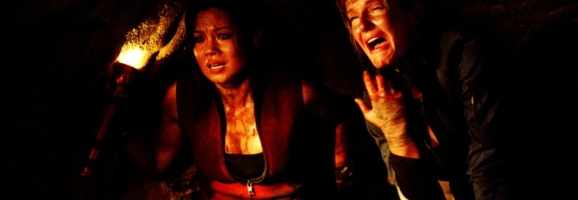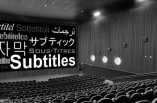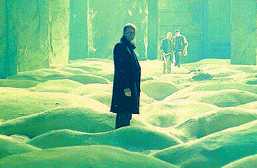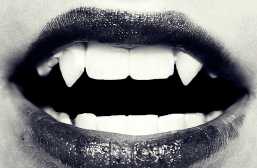The Descent: The Last Great Horror Film

A frank assessment to begin: There are very few contemporary horror films worth watching. The Cabin in the Woods (2011), while enjoyable, is vastly overrated, and despite my willingness to defend The Purge (2013) as a fun time at the movies, I don’t think it is the next horror masterpiece. Let the Right One In (2008) is a beautiful love story with a few gory death scenes, but to classify it as a horror film is stretching the genre to the point where it becomes meaningless and arbitrary. If Let the Right One In is a horror film, so, too, is Pan’s Labyrinth (2006). In other words, Let the Right One In is not a horror film, but it does contain a few horrifying moments. To me, a horror film must deliberately elicit an uncomfortable emotional response from the viewer, but it must do this by tapping into the viewer’s deepest fears.
If the box office success of recent entries in the horror genre are any indication (see The Purge, Mama, the Paranormal Activity franchise), audiences still find pleasure in being frightened by the movies. If the “Horror” section in Netflix’s instant streaming service is any indication, a plethora of random titles like Shrooms (2007) and Fear Island (2009) are offered to die-hard horror fans (presumably the only people watching this drek) as if horror fans are heroin addicts who will take anything they can get to satisfy their craving for terror. Instant accessibility to these titles may feel like Christmas, but in reality it is the equivalent of finding a lump of coal wrapped in red paper.
Horror fans deserve better than lazy efforts like Shrooms, and horror filmmakers (and producers, distributors, and financiers) can do better than nonsense like Fear Island. The fact that the last truly great horror film was Neil Marshall’s The Descent (2005) shows how badly the genre is in need of a revamp. Where is this generation’s Wes Craven when we need him (or her)?
Although some may argue with my choice of The Descent (*gasp* what about Slither!), if you are indeed a horror fan, there is absolutely no denying that The Descent is one of the few contemporary horror films that represents the best the genre has to offer. Therefore, I will use The Descent as an example of great horror, and I will show how Marshall and his production team manage to create this horror for the audience to enjoy.
Since film is creation and creation is artifice, there is a formula for a successful horror film. The formula is not a science, and indeed, some films that follow it are not always scary. However, films that fail to follow it are never scary, which explains why the formula is necessary and why it demands our attention. As I will demonstrate with The Descent, a successful horror film must meet five specific criteria.
First, a few clarifications. I do believe that there is such a thing as scary and not scary, and I don’t necessarily believe that it is subjective. I am certainly not a cognitivist, and I do make room for cultural specificity and historical relativism. For instance, films that were scary to audiences in the 1920s, like Nosferatu, aren’t necessarily scary to audiences today. Having said that, I do think that The Descent is a truly scary film, and I do believe that if one thinks while watching The Descent that they are not scared by the film, then one does not know how to be affected by cinematic horror. At the very least, even if one isn’t scared by The Descent per se, one should be able to understand why a film like The Descent is successful horror. Just as there is more to a comedy than making a person laugh, there is more to a horror than making a person scream. This leads us to the five specific guidelines that filmmakers must follow if they want to create successful cinematic horror.
The first thing a filmmaker must do is deliver a concept. This can be a narrative or a stylistic concept, and in many cases, the filmmaker can combine the two. For instance, The Descent is a relatively simple film about six college girls who embark on a caving expedition, only to find that they become trapped inside of the cave and must defend themselves against a strange breed of monsters that lurk in the dark shadows of the cave. There is nothing complex or original to this narrative concept, but it is designed to create successful horror. In addition to the narrative concept, the film adopts a stylistic concept. The stylistic concept is essentially how the filmmakers choose to present the narrative concept. In The Descent, the filmmakers use hand-held camerawork to create a documentary-like feel, as if to suggest that the audience is observing something that can really happen. Another more famous example of a stylistic concept is The Blair Witch Project (1999). A famous example of a narrative concept is Jaws (1975), i.e., a shark terrorizes a local community. I would argue that most horror films develop simple concepts, and the more complex concepts like The Cabin in the Woods result in failed experiments as opposed to successful horror.
Next, a horror film must make the audience care about its characters. Otherwise, what is the terror in watching a character fear for his or her life if we have no investment with them? Some horror films do this better than others. For example, Wes Craven’s Scream trilogy brilliantly makes us care for Sidney Prescott (Neve Campbell). I couldn’t say I felt the same about the caricatures in Urban Legend (1998). Typically, filmmakers will throw in a back story or some flashback that makes us sympathize with a protagonist, or strong bonds will develop between the characters who are in danger. In The Descent, the six women come together over the death of one of their friends, and this death is shown in the film’s opening scene. As the film progresses, we understand the bonds that tie these girls together, and the trauma they have been through prior to their caving expedition. This makes the horror they experience in the cave all the more powerful as we root for their escape and survival.
Third, the filmmakers must properly utilize the space of the cinematic screen. That is, they must be conscious of what they show and don’t show. Since The Descent takes place within the confines of a cave, the camerawork is often closed in on the characters to make the audience feel as claustrophobic as the characters do. As an audience, we are never a step ahead of the characters, and this creates an enormous amount of tension as we, like the characters, are uncertain about what lurks beyond the frame. Consider some of the early scenes where the girls are simply crawling through tight spaces inside of the cave, unaware of where they are headed or whether or not they will make it through. Virtually nothing happens here, but the brilliant camerawork creates unease and tension as we feel like the walls are closing in on us as well. Linda Williams describes the horror genre as a body genre, in which we react not with our minds but with our bodies. The way cinematic space is utilized in The Descent surely makes us feel as uncomfortable as the characters. Other notable horror films that successfully use cinematic space are Repulsion (1965) and Halloween (1978).
In addition to cinematic space, filmmakers must take advantage of light or the absence of it. This is yet another reason why The Descent is such a masterful work of cinematic horror. Not only does the cave enclose the characters in tight spaces, but it also forces them to lurk in the darkness. The only light available comes from the flashlight-helmets that the characters wear. This becomes more terrifying as the film progresses because we never know exactly where the creatures are going to be, and neither do the characters. The best horror films play with our fear of the dark, and The Descent is no exception. Other classic examples include The Texas Chainsaw Massacre (1974), Les Diaboliques (1955), and The Cabinet of Dr. Caligari (1920).
Finally, filmmakers must know how to use sound. The reason why so many horror films fail, I believe, is because they amp up the music at times when silence would be more frightening. The Descent works so well because most of it is quiet. Not only does the film avoid an overbearing score, but it also makes use of the ambient noises inside of the cave, like echoes, creaks, and distant droppings of water. The greatest horror films understand the power of silence. Consider the scene in Jaws where the shark swims toward the pond. For a few seconds, the soundtrack becomes quiet, and we can only hear the sound of the shark dipping its fin under water. That silence is more terrifying than any other moment in the film. The same applies to the silence in The Descent. Luckily for viewers, the silence sustains most of the film, leaving us with the echoing screams of six women who are forced to fend against strange predators in the dark, confined spaces of an unfamiliar cave.
I don’t doubt that there are other ingredients that can go into a successful horror film, but I maintain that the above five are the only necessary ones, and if a horror film fails to meet all five criteria, it will not be successful. The Descent is the last horror film to successfully meet all five criteria, and as a result, it is the last great horror film cinema has given us.
What do you think? Leave a comment.











I agree about the silent aspect of this film, it really does ramp up the horror aspect and the issue of claustrophobia in ‘The Decent’ plays on fears most of us have and can relate too. It has an element of realism.
And then they give us a sequel that we can title ‘ignore’.
The elements you’ve listed are not specific to the horror genre – I suspect any filmmaker who can’t offer compelling characters, use sound design appropriately (especially important in horror admittedly) or use space in an interesting way is going to fail.
I’ve always been interested in the overlap between the thriller and horror genre. I feel like the main difference between extreme ‘thrills’ and true horror is that horror stays with you – it’s psychological, not physical. I therefore disagree with Linda Williams on this count – sure, the body reaction is present, but it really needs to lead to a psychological reaction as well. A really great horror film reveals something about humanity that you wish had remained hidden. I don’t know if The Descent does that, since I fell asleep while watching it. In that sense, though not conventional, Let the Right One In is, indeed, a horror film (crossed with a coming-of-age film, but the fact it also belongs to another genre does not negate its place in horror).
Have you seen Whatever Happened to Baby Jane? That is quite definitely a horror film, but the horror is creeping and intellectual – it comes from the shock of seeing horrible people do horrible things, not from a kind of thrilling surprise reaction brought about by clever use of shadows or jump sound effects.
Anyway, after that silly rant, I thought I’d recommend a couple of other films you might like checking out – [REC] and [REC] 2 (the first is best… obviously), The Silent House and We Are What We Are. All are more recent than The Descent, and all are, I think, rather good (though I honestly fell asleep in We Are What We Are, so can’t give you a personal guarantee on that one). [REC] was remade as Quarantine, but that movie is atrocious and should be burned at the stake. I don’t know how they managed to screw it up so bad.
Thanks for the response. To be clear, this is a work in progress so I appreciate the dialogue.
I think it is fair to say that the criteria can apply to other films as well, but I do think, for instance, that other genres don’t necessarily benefit from utilizing silence as much as horror, or for manipulating deep and shallow space, or for playing with light and dark (film noir perhaps but few other genres rely on this as much).
Linda Williams also discusses horror from a psychoanalytic perspective but I’m trying to move away from that, which explains my emphasis on formal aspects of the genre.
In other words, I’m trying to say that there is such a thing as a successful horror film before it is screened in front of an audience, and we can measure this based upon certain criteria (mainly formal features of the film. As a result, this distances the discussion from psychodynamics that has too long dominated horror studies.
But in any event you raise some interesting points that will cause me to rethink some of my argument.
The Descent has been probably the only horror film where the “monster” has been shown on camera and I haven’t sniggered. You’re right in referencing that horror is a body genre, and this is totally implemented by The Descent. I think perhaps the monsters in the film would have been as ridiculous as, say, the monster in Boogeyman or Jeepers Creepers, had it not been for this claustrophobia that is omnipresent throughout the film. However I would disagree that it was the last great horror film. As mentioned above, [REC} was one that really stands out as a proper, similarly claustrophobic, and incredible horror film, and if you haven’t seen it is definitely worth a watch.
Interesting article, and I agree the Descent is a very strong film. I also liked the intro, discussing how horror elements can interplay in other genres. The only time I can remember being horrified in any film, was indeed Pan’s Labyrinth, when the creature with eyes on his hands began slowly chasing Ophelia. Odd, I know, but isn’t it funny what fears play on certain people.
Great analysis, Jon! I’m not much of a horror fan, but I agree that The Descent is a true masterpiece. I saw it with my sister in theaters and knew absolutely nothing about it going in, which I still maintain is the best way to experience such a wild and unpredictable film. Your dissection of silence, darkness, and space really hits the nail on the head, as The Descent is so masterfully crafted and choreographed from a technical standpoint. I also love that the first half of the film derives its scares from very real and natural occurrences, but that once you encounter the “game changer”, so to speak, all hell breaks loose and you can’t escape it. Excellent horror that never loses its edge with repeated viewings.
Great article! I love The Descent and definitely agree that music (or lack of) can make or break a film. But I do think that some of the best horrors are the ridiculously over-the-top, almost camp B-movies that make you laugh rather than scream – like the Hellraiser series.
I love the descent, but for me it’s either REC or Inside. Both are brutal and, I think, came out int he same year? Either way, they were after The Descent and are masterclasses in horror film-making.
Love your article, love The Descent, but I must disagree with your opinion on The Cabin in the Woods (sorry, I have a soft spot for that one!). Very nice analysis otherwise.
Really interesting, analytical article!
This is one of the best horror films I have seen in the last ten years. I think one reason it is great is because it make you care about the characters, and they have a back story that is just as important as the horror elements. There are so few horror films with good character development.
What I think? I think the movie was absolute trash and over-hyped.